![]()
“Philanthropic innovation is not just about creating something new. It also means applying new thinking to old problems, processes and systems”
-Laura Arrillaga-Andreessen
Consider the many environmental, humanitarian, and social problems facing the world today. Confronted with these challenges, most people express that they care. Of these, many are moved to support charities that address these problems. And of these, some are ready to get involved by working in the nonprofit sphere. And just a handful of these service-minded professionals are inspired to make nonprofits run as efficiently and effectively as possible through better business practices.

People tend to think about a nonprofit’s values and mission first, and its business practices second. In fact, the two are inseparable. A nonprofit must have sound budgeting, strategy, marketing, and personnel management in order to survive, thrive, and deliver on its mission. A nonprofit MBA provides the training to improve the way a nonprofit does business. With an MBA in nonprofit management, you’ll be qualified to take on a variety of administrative, managerial, and leadership roles in all types of nonprofits, from charities and government institutions to schools and hospitals. A nonprofit MBA is associated with a good paycheck, meaningful work, and exceptional job satisfaction. Read on to learn the ins and outs of an MBA in nonprofit management and the many rewarding career opportunities this degree offers.
What is Nonprofit Management?
Like traditional business management, nonprofit management is all about steering an organization- in this case, a not-for-profit- to fulfill its mission through organizational governance, administration, finance, and entrepreneurship. But instead of creating growth and maximizing profits, nonprofit management’s goal is to more effectively and efficiently serve the organization’s charitable cause. Whether that means raising awareness for multiple sclerosis, promoting solar power, or rescuing dogs and cats, a nonprofit manager can foster success through effective outreach, careful budgeting, sourcing revenue, building public awareness, and building strong employee relationships.
Some of the roles a nonprofit manager may play include:
- Creating an operating budget
- Reporting to the board of directors
- Formulating strategic plans
- Managing staff
- Overseeing fundraising
- Maintaining public relations
- Ensuring adherence to nonprofit regulations
Depending on the size of the organization, a nonprofit manager may wear several “hats.” At smaller charities, for instance, a nonprofit manager may handle both outreach and oversee fundraising. For this reason, nonprofit MBA programs provide a broad background in different job functions.
How Does an MBA Help a Nonprofit?
According to a recent article in the Huffington Post, charities benefit from the services of nonprofit MBAs in several key ways:
- Analyzing Problems Nonprofits address complex social problems like homelessness, addiction, illiteracy, and environmental degradation. MBAs have the training to approach these problems from a systematic and analytical perspective, determining which approaches have proven most and least effective, and fine-tuning interventions to make a more effective impact.
- Effective Leadership Nonprofit executives tend to be primarily motivated by dedication to the organization’s mission, and often come into their roles without formal training in essential leadership skills, learning instead as they go. A leader with a nonprofit MBA brings to the table formal training in effective communication, team building, conflict resolution, supervision, and other core leadership skills.
- Business Skills While some charities scoff at those who run their nonprofit “like a business,” there’s a lot to be said for doing exactly that. Making the most effective use of those precious donor dollars requires best practices in accounting, finance, and economics, all fundamental business skills that many nonprofits are sorely lacking. A professional with a nonprofit MBA can apply the business principles nonprofits need to survive and thrive.
- MBA Nonprofit Environment A growing number of schools now offer on-campus and online nonprofit MBAs. Students in these programs have exposure to the problems and opportunities unique to nonprofits and up-to-date frameworks and innovations in how to best address them. Nonprofit MBA students also develop powerful professional networks, including peers, guest speakers, fellows, and professors. They are then able to leverage these influential connections to better serve their nonprofit employers, as well as advance themselves professionally.
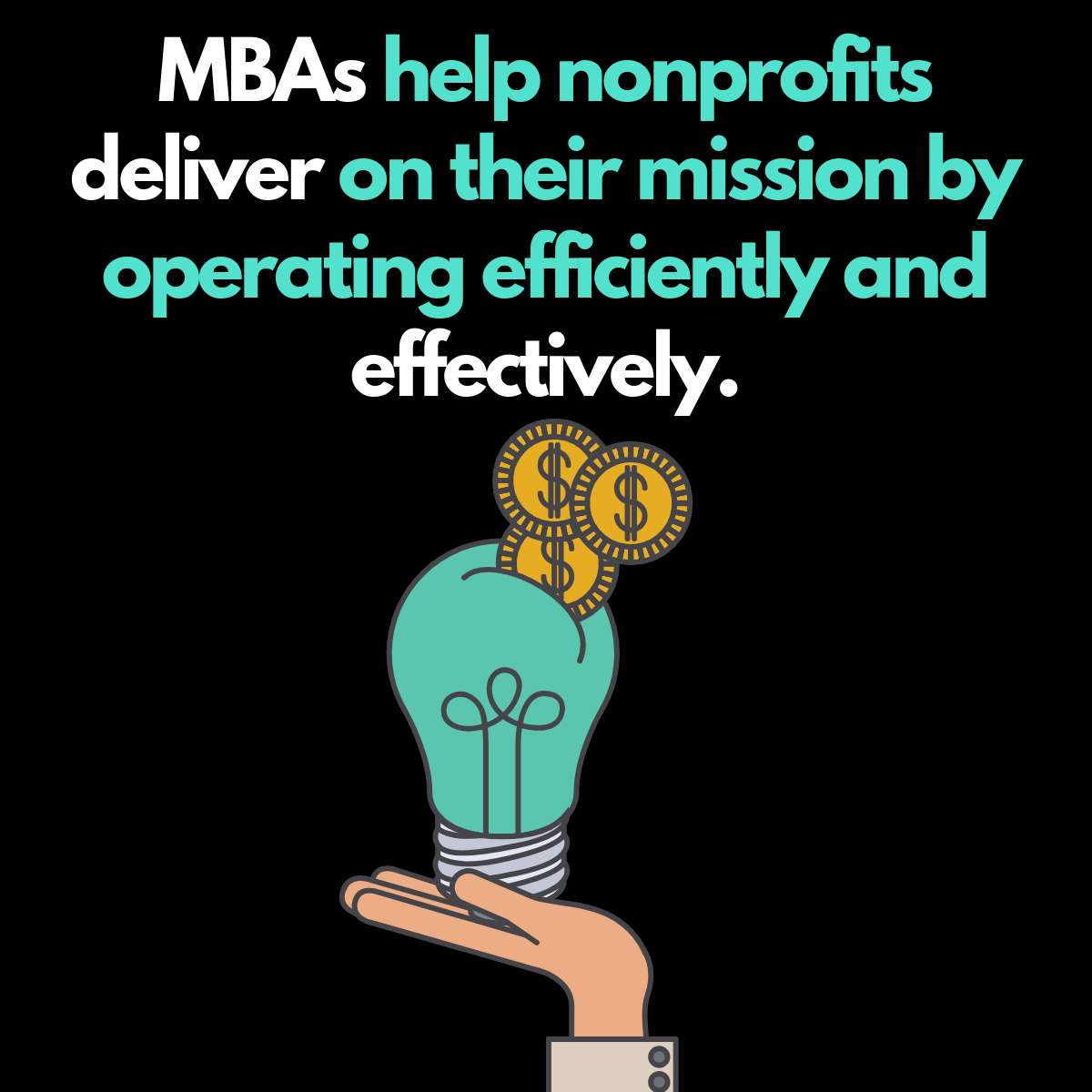
How is Nonprofit Management Different from For-Profit Management?
The main difference between a non-profit and a for-profit company is right there in the name: profits. A for-profit corporation’s mission is to generate profits and grow its market share, and income is generated by customers who choose the company’s service or product. In contrast, a non-profit’s mission is to provide services within a defined cause. That means the consumers of a nonprofit’s services aren’t necessarily the source of sustaining income. Those additional funds need to be generated through sources like:
- Fundraising initiatives
- Memberships
- Donors
- Foundations
- Grants
- Investments
- Corporate sponsors
Keeping these revenue streams flowing and tying them together to create long-term sustainability presents a special challenge. In addition, budgeting and management for charities requires a high level of transparency, since funders want to know exactly how their contributions are being used. And, compared to the corporate world, budgets for nonprofits tend to be tight, meaning there’s a slim margin of error and a higher rate of employee turnover. That makes an effective and innovative leader who can run an efficient operation a powerful asset to a nonprofit’s mission.
Beyond funding, volunteers are another asset that separates nonprofits from private companies. This source of unpaid labor is essential to most nonprofits’ day-to-day operations, and a great nonprofit leader can effectively increase and manage the organization’s volunteer base. Corporations do benefit from the unpaid services of interns, of course, but their motivations are fundamentally different.
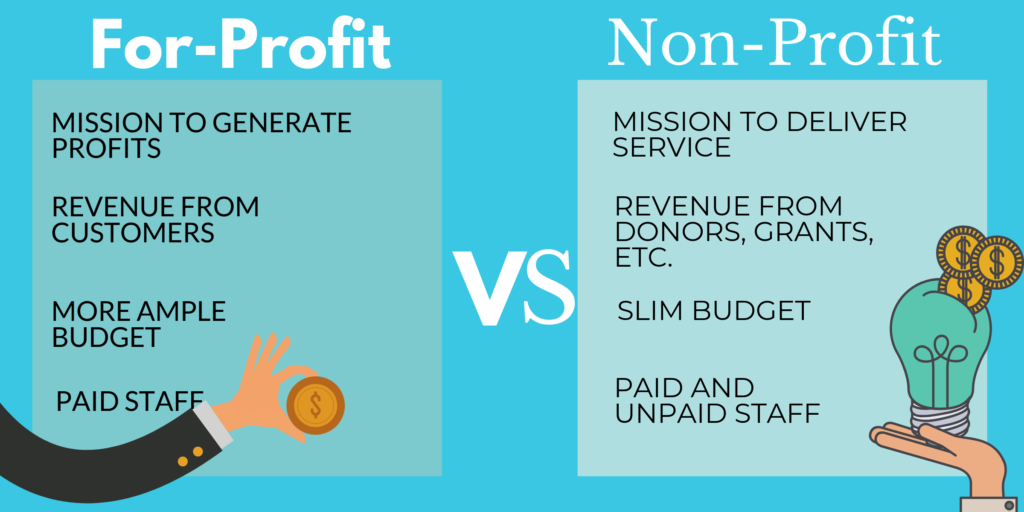
Metrics are another crucial difference in managing a nonprofit. It can be difficult to measure institutional success in the nonprofit world, especially in fields like policy and advocacy. Instead of simply looking at market share or tracking profits, charities need to find ways to quantify and measure their impact. Developing metrics to assess their efficacy is more complex in this sector, though an essential task.
Both nonprofits and private companies care about their image, of course. For-profit companies invest heavily in marketing to ensure that the public is aware of their product or service and views it favorably. But this area of management is even more crucial for nonprofits. After all, consumers regularly pay for items or services without any thought about which company provides them (as is often in the case for small purchases), or even grudgingly make a purchase out of convenience or necessity from a company they dislike. But donors and grant makers choose to support charities based on their perception of a nonprofit, including its values, integrity, and efficacy. Nonprofit managers, therefore, have to be scrupulously mindful of their employer’s public image in every business decision.
As a recent article in the Stanford Social Innovations Review pointed out, most nonprofit managers are on a fundamentally different career path than their peers in the private sector. Most nonprofit executives are driven by a commitment to making a difference in the world by fulfilling an organization’s mission, and are committed to a leadership role as the best way to achieve that goal. By contrast, executives in the for-profit sector are usually motivated by a desire to lead, and seek out industries and companies where they can take on high-level positions, with the company’s mission of secondary concern.
What that means for nonprofits is that their leadership is more committed to their mission than that of a private company, and may have more professional loyalty, but usually brings less innate managerial and leadership talent to the table. As a result, business oversight and management in the nonprofit sector has traditionally lagged behind that of the private sector. This makes the services of a professional with an MBA in nonprofit management all the more valuable, especially for nonprofits looking to turn around their flagging finances, expand their services, or weather an economic downturn.
What is a Nonprofit Management MBA?
An MBA is a focused, graduate-level business degree which prepares graduates for an array of managerial roles. It typically takes two years to earn an MBA with full-time enrollment. For those who want to fast-track their education, there are, as we’ve covered in the Best Accelerated MBA Programs, quite a few schools offering accelerated MBA programs, which compress the typical curriculum into as few as 19 months. Part-time enrollment, on the other hand, can make an MBA program last 3-5 years.
From start to finish, and MBA is all about business, and provides a multi-disciplinary and well-rounded background in all the fundamentals of business, from human resources management to marketing. In addition to this broad foundation, most programs also offer the opportunity to specialize, either through the selection of free business electives or by opting for one of a selection of concentrations, such as strategy, finance, or healthcare management.
A nonprofit management MBA is simply a traditional MBA with a concentration in nonprofit management. The curriculum for an on-campus or online nonprofit MBA typically focuses on general business classes in the first year, then incorporates classes specific to nonprofit management in the second year. This allows students to bring their foundational knowledge about business principles like marketing and strategy to their studies about the business of nonprofits.
In spite of the nonprofit specialization, a nonprofit MBA is still, first and foremost, a business degree. MBAs are sought-after degrees with a high potential earning power. This means that those with an MBA with a nonprofit management specialization decide to eventually move into the private sector, they’ll still have a desirable (and potentially lucrative) credential.
What do I Need to Get into School for an MBA in Nonprofit Management?
An MBA is a special type of masters-level degree, with a unique focus on business management and the application of principles to real-world problems. It’s no surprise that the entrance requirements for an MBA are also different from those f a typical graduate degree. To get into business school for a nonprofit MBA, you’ll usually need the following:
- Bachelor’s degree
- GMAT score of 600 or higher
- GPA of 3.0 or higher
- 2+ years’ experience with nonprofits/business
- Resume and Personal Statement
- Letter(s) of recommendation
What Classes Will I Take for a Nonprofit Management MBA?
Every school has its own MBA curriculum, with different course titles, program structures, and outside learning opportunities. In general, you can expect to spend the first year of a two-year program focusing on the fundamentals of business, with classes like:
- Marketing Management
- Operations Management
- Quantitative Analysis
- Microeconomics
- Macroeconomics
- Global Strategy
Once you’ve developed a solid business background, you’ll typically begin your concentration, and take 3-4 classes in the area of nonprofit management. Common course titles in the nonprofit management specialty include:
- Leadership and Crisis Management
- Ethics and Leadership
- Public Economics for Business Leaders
- Sustainability Across the Enterprise
- Advanced Board Governance
- Social Innovation: Designing for Change
- Health and Human Rights
- Education Consulting
In addition to classes such as those above, you’ll also complete a capstone course, which can take the form of a thesis or project. The purpose of the capstone is to synthesize your prior learning to complete one large portfolio assignment and showcase your skills for potential employers. Most schools also offer experiential learning opportunities, such as internships or practicums, which allow you to develop real-world business skills. Many students eventually find employment through their internship sites.
How Much Does an MBA in Nonprofit Management Cost?
Every school sets its own tuition, and the cost of business school can vary wildly. A prestigious private school can cost $150,000 per year. Public schools are cheaper, especially for in-state students, and online MBAs also tend to cost less. In general, you can expect to pay about $60,000 per year in tuition. In considering this cost, don’t forget to factor in the additional cost of textbooks, laptops and devises, business school fees, and the cost of commuting, if you’re not attending an online MBA program.
With a nonprofit MBA, value matters. This MBA specialization is highly rewarding and brings enormous career satisfaction, but it’s certainly not the most lucrative business school degree. A nonprofit MBA is associated with a good salary, but one far lower than that of MBA concentrations like finance or strategy, yet the tuitions for both are identical. You’ll want to consider carefully what you can afford in initial tuition investment in light of how much you can expect to earn.
You’ll also want to explore your options for funding your studies. Some employers pay all or part of business school tuition for their executives, with the understanding that the new skills they bring to the company table with an MBA will provide enough value to justify the initial cost. In the case of a nonprofit management MBA, you’re unlikely to find an employer who can foot the bill for tuition, since most nonprofits have tight budgets with little room for discretionary employee education. You’ll almost certainly need to find ways to finance your own MBA tuition. Options to do this can include:
- Business and external scholarships
- Business school fellowships
- Federal and private student loans
- Teaching assistance positions
- Employer education sponsorship
Can I Earn a Nonprofit Management MBA Online?
Nonprofit management is one of the newest MBA concentrations to emerge, and remains less widespread than traditional specializations like finance, human resources, and marketing. Online MBAs are also a newer development, and though the number of online MBAs has grown dramatically, they are still catching up to the popularity of on-campus MBA programs. Taken together, this means that there are not yet a great number of business schools that offer an online nonprofit MBA.
Nonetheless, it’s still quite possible to earn an online MBA in nonprofit management. In fact, we’ve recently ranked a number of outstanding programs in the 10 best online nonprofit MBAs. Online MBAs are an excellent choice for those already employed in the nonprofit or business field who wish to continue working while pursuing an advanced degree. An online MBA offers flexible scheduling, with both live and on-demand course content, and saves working students the need to commute to campus. This is especially important to those online MBA students who are balancing family obligations in addition to work and school, or who frequently travel for work.
What Jobs Can I Get with a Nonprofit Management MBA?
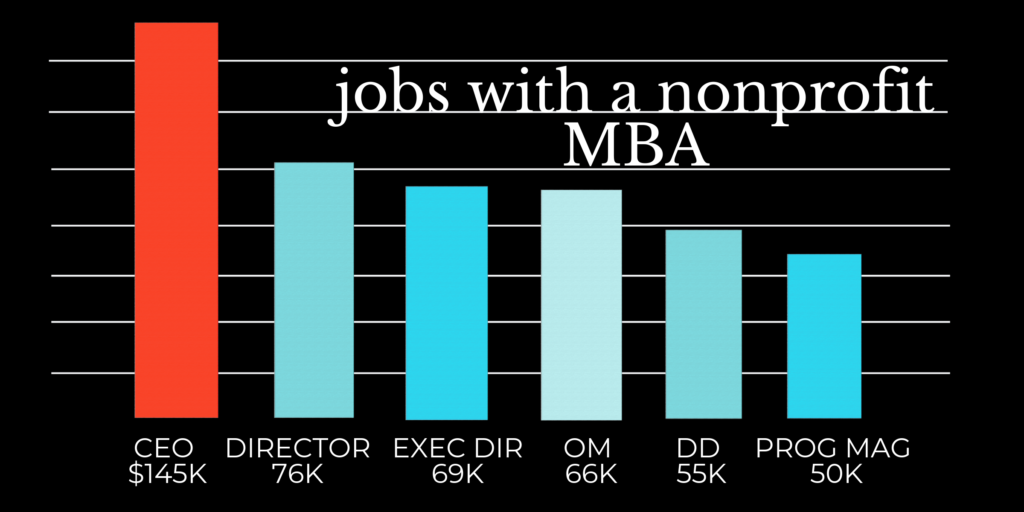
The job title you hold will vary based on the industry and company where you choose to work. At smaller companies, your job may overlap with other positions. For instance, as an executive director at a small charity, you may find yourself sharing some fundraising duties with the program director. Your salary will also vary based on the size of your company and its budget, as well as your level of responsibility and years of experience.
Some common job titles and associated average salaries with a nonprofit MBA, according to PayScale, include:
- Chief Executive Officer (CEO): $145,202 average salary
- Director of Operations: $76,605 average salary
- Executive Director: $69,917 average salary
- Operations Manager: $66,253 average salary
- Director of Development: $55,445 average salary
- Program Manager: $50,405 average salary
Where Can I Work with a Nonprofit Management MBA?

There are over one million charities in the US alone, along with nonprofits in every country in the world, and plenty of international nonprofits with global missions. Every one of these is a potential employer for those with a nonprofit MBA. If you’re considering they degree, you likely have an issue that’s already important to you, as the number of charitable causes is practically limitless. Some of the most popular charitable causes include:
- Environmental protection
- Child welfare
- Animal welfare
- Health and wellness
- Homelessness
- Gender parity
- Peace
- Disaster relief
- Population displacement
- Addiction
- Offender rehabilitation
- Climate change
- Racial bias
- LGBTQIA rights
- Poverty
- Arts access
Within each field, there are hundreds of charities, each with its own mission, approach, structure, and business culture. The biggest nonprofits have been around for decades, surviving economic downturns and tough political climates through savvy management. Many people with an MBA in nonprofit management will feel at home at a large and well-managed nonprofit. According to Forbes, the largest charities are:
- Feeding America
- Americares Foundation
- Salvation Army
- St. Jude Children’s Research Hospital
- Direct Relief International
- Habitat for Humanity International
- Boys & Girls Clubs of America
- YMCA of the USA
But large, established charities aren’t the only place you can find work with a nonprofit MBA. You can help a grassroots charity grow from a startup to a major charitable enterprise. You’ll also be uniquely qualified to found your own nonprofit with this credential, as your demonstrated business savvy can help you convince founding donors of your ability to create a lasting endeavor, and attract a high caliber board of directors. You can also find work as an executive in hospitals or health initiatives, schools or not-for-profit universities, museums or even government institutions.
How Much Can I Earn with a Nonprofit MBA?
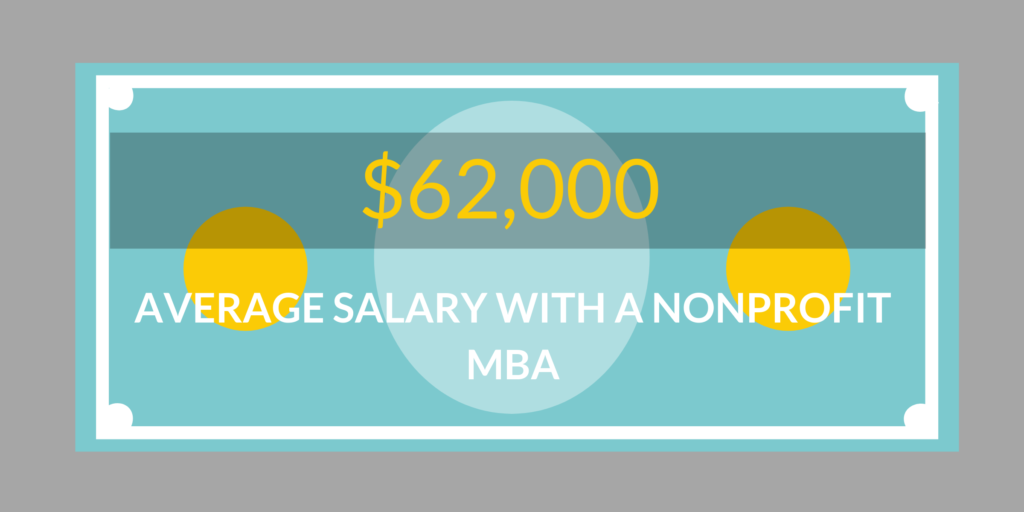
You can earn a good salary with a nonprofit management MBA, but there’s no denying that this concentration is not as lucrative as other popular MBA degree specializations. According to Payscale, you can earn an average salary of $62,000 with a nonprofit MBA. By comparison, the average MBA is associated with an average salary of $85,000, and the most lucrative concentration, strategy, brings in an
As in any industry, experience brings in higher salaries as well, opening the way for more senior positions that bring in higher salaries. You can expect your salary to grow as you accumulate experience and build your professional reputation. There’s more good news about salaries in the nonprofit world- an upward trend in compensation. A
broad survey of the different industries found that the nonprofit sector is tied for third-highest salary growth, with an increase of 1.7% in the past year.
What is the Job Market with an MBA in Nonprofit Management?
If you think that your nonprofit MBA degree won’t lead to great job prospects, think again. A recent survey of the top 10 industry specializations that MBA employers are looking for revealed that Nonprofits & Social Enterprises made the top five, alongside more traditional fields like Finance, Technology, Consulting, and Consumer Products.
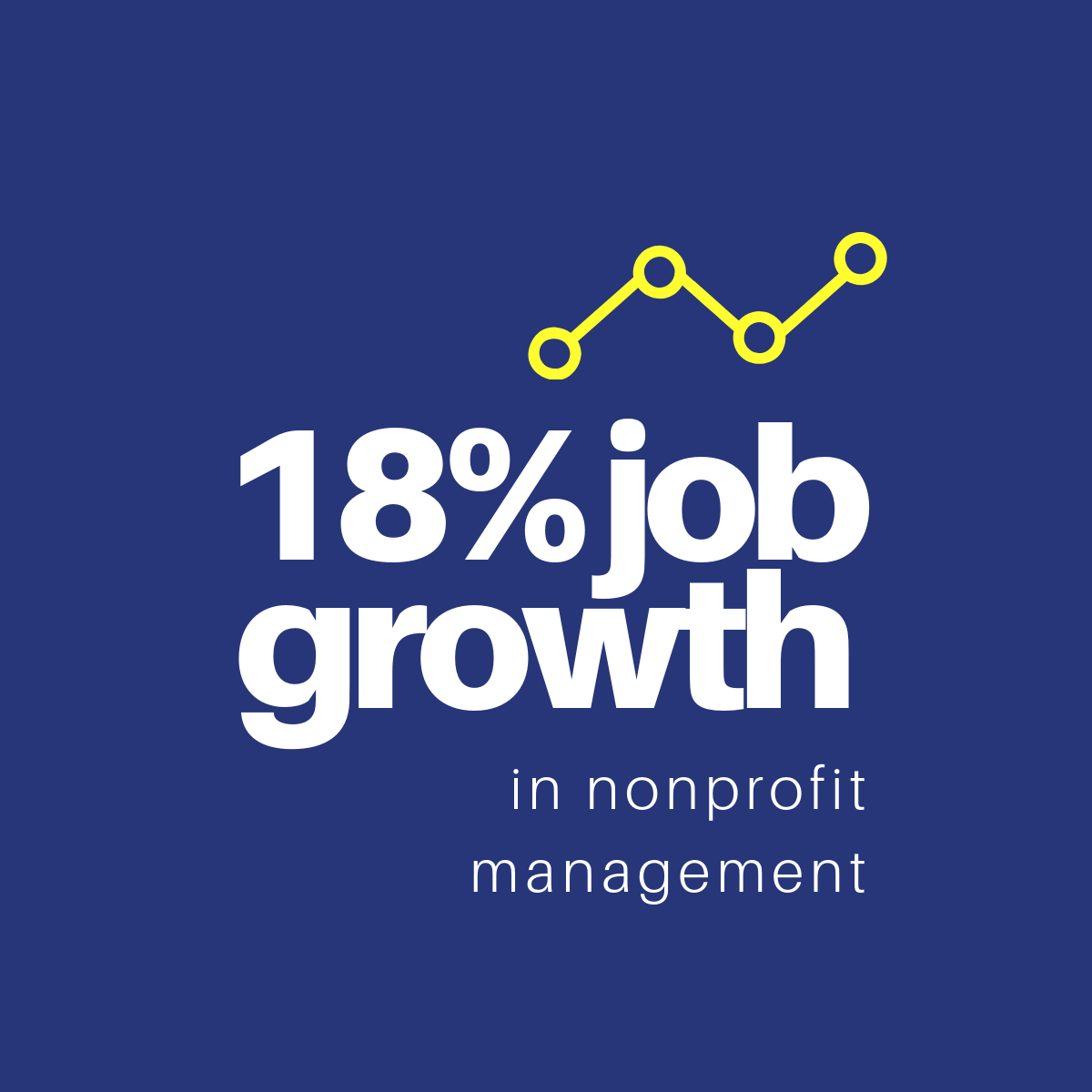
The Bureau of Labor Statistics (BLS) anticipates that the job market for Social and Community Service Managers will grow 18% between 2016 and 2026. That puts nonprofit management far ahead of the overall national job growth rate. Much of this growth reflects an increasing need for services, especially in the fields of elder care, addiction treatment, health, and environmental protection.